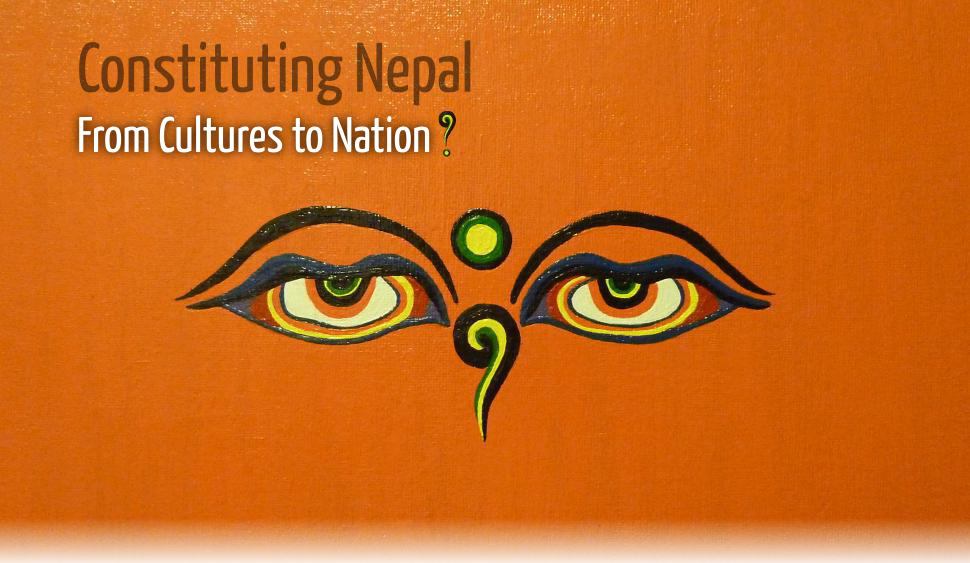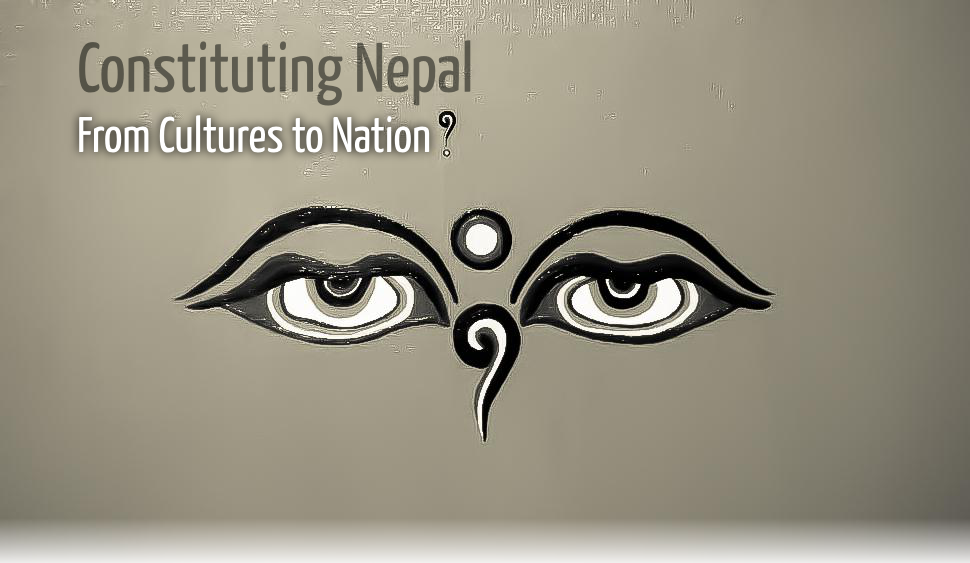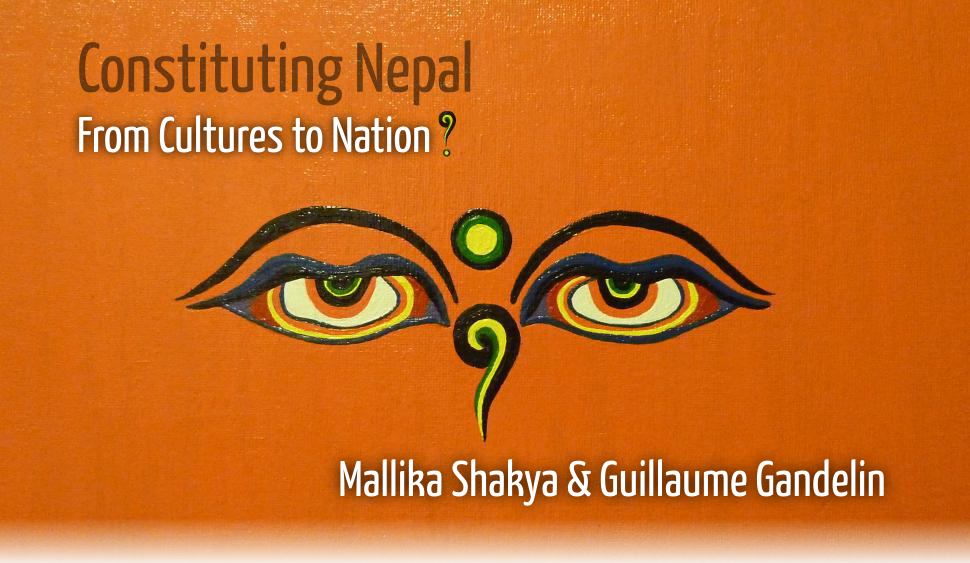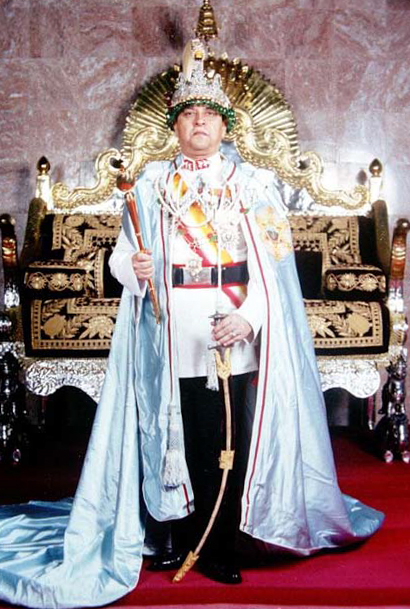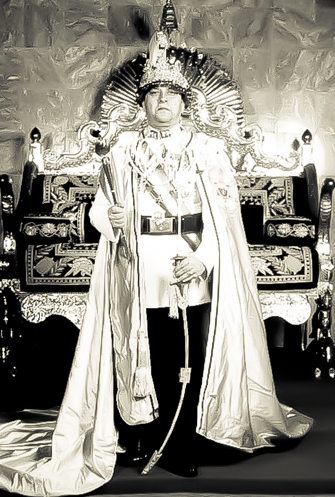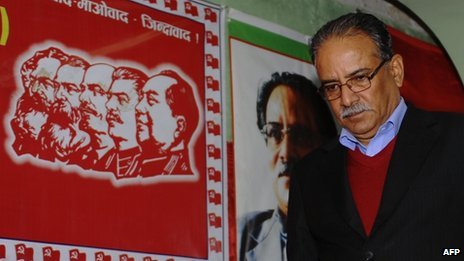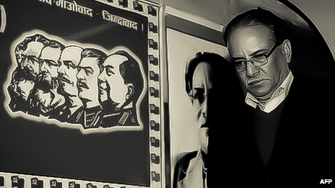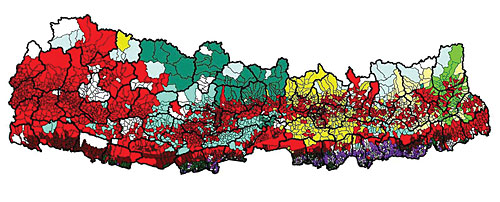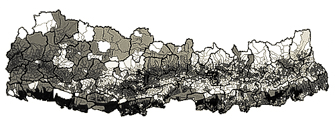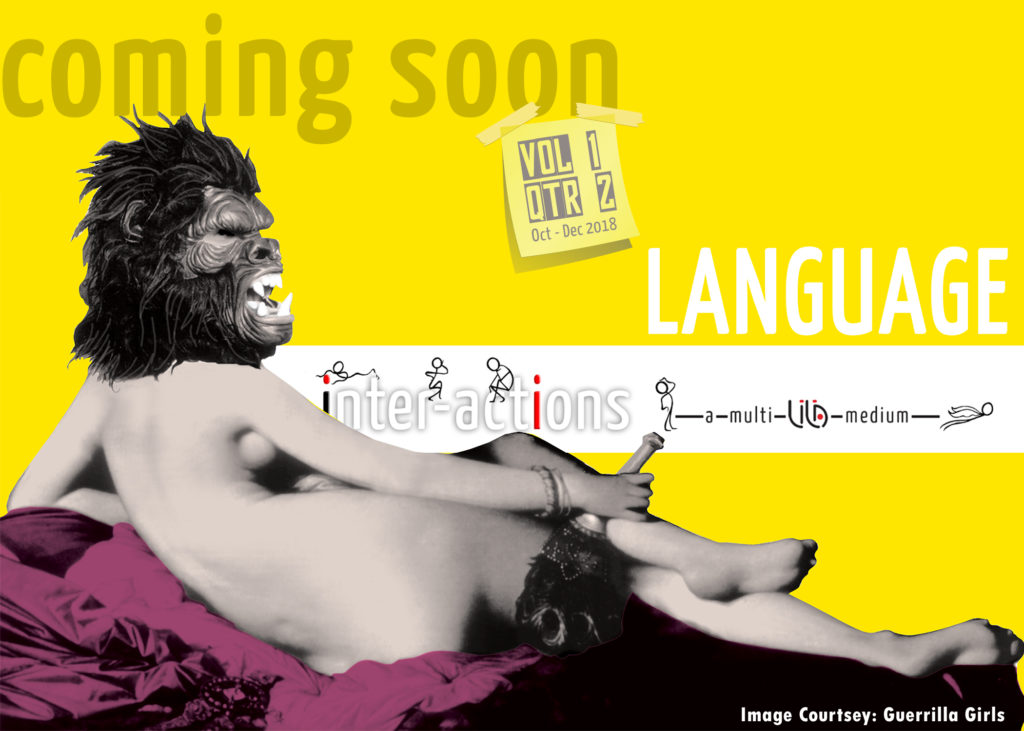|
23 January 2015
Was it anger, sadness, or perhaps resignation that shook Nepal a few days back, when TVs from around the world presented physical fights within its Constituent Assembly? Blaming the pettiness, hypocrisy or veiled interests of politicians would be everyone’s legitimate reflex. But this kind of event always testifies the deeper ramifications of the present deadlock: when leaders leave the politically correct for vandalism, it may be that the worlds of words have been breached, that the participants do not speak the same language anymore. After an initial attempt at a Maoist government following the bloody end of the monarchy, the wheel has turned and more classical parties took over the reins in 2013, carrying along the prickly test of drafting a national Constitution. This sharp hostility between the parties in power and the opposition reflect a major alternative, whose resonances will accompany the future of all our pluralistic nations. On the one hand, historic parties promise stability but respond too often to cultural variations by siding with the majorities and the powerful. On the other, people’s movements dedicate entire lives of ideas and actions to humanistic dreams, but resist the identity categories that nation building demands. Will nationhood and pluralistic cultures become one day an oxymoron? This week on LILA Inter-actions, Mallika Shakya goes beyond the romantic veil of Nepal, and points to gender inequality as an instance of the profound lacunae in the democratic ethos, before and beyond any constitutional ambitions. Guillaume Gandelin assesses the risks of both political centralisation and ethnic separatism, and places his hopes behind a revived polity.
Debate
Hold the cursor on the illustrations to display animations.
|
|

Nepal is a romanticised geography: A Himalayan Shangri-La that went on to wage a Maoist revolution that ousted monarchy, while forging a democratic alliance committed to address the aspirations of the downtrodden of all sorts. The only problem with such unbounded optimism is that the spirit of revolution seems defeated in Nepal at the moment. It is not easy to blame anyone in particular but fingers can be pointed at two. The Nepali Left clearly squandered its own opportunity. But it cannot also be overlooked that the Western scholarship has either depoliticised the Maoist movement and called it ‘village youth’s participation to modernity’ or exaggerated its political significance, as if it is the only power filling the vacuum of a national scale. Both smack of exoticisation.
A midnight riot broke out on Monday night in the Constituent Assembly among its elected representatives, as their Party leaders failed to forge consensus two days before the deadline to write a new constitution. The first constitutional deadline was missed four years ago. Several other deadlines have been missed since; the final one being May of last year. An election then altered the Party equation in the CA, but it remained caught in the same impasse – how to define a modern Nepali nationality that respects the diversity in ethnicity, regionality and caste? Nepali women also hoped for patriarchy to be bridled in a so-called ‘new Nepal.’ It is unfortunate that the country is struggling so badly to forge a nationalism acceptable to all its citizens.
The fall of King Gyanendra did not suffice
to satisfy all the democratic ambitions
The current crisis is clearly rooted in its past. In the 1960s, when the rest of South Asia was celebrating national independence, King Mahendra staged a coup against the democracy because it threatened his idea of Nepal as a hill-Hindu- patriarchal state. The Panchayat was ousted in 1990 but the Panchayati bureaucracy remained in place. A decade later, when those outside this narrow ambit raised voices of dissent, the elite first romanticised their rebellion and then came down hard on them. The revolutionary euphoria of the Comprehensive Peace Agreement of 2006, which dethroned King Gyanendra and declared Nepal a secular state, was a momentary pact between the elite and the everyman (and woman). As the spark of the revolution extinguished, the unlikely bedfellows have since parted ways. The ideological and political polarisation that followed since split the intellectuals and media to generate a hegemonic discourse on who is more Nepali than whom. By the time a new constitution was drafted, the elite (and male) distrust of the commons (and women) had reached such new heights that any deviation from the Panchayat-era Nepaliness provoked fears of secession and national disintegration. The Janajatis from the hills, the Madheshis from Terai, the Christians and the Muslims, and the poor and the Dalits have all faced the wrath of the xenophobic nationalists at one point or the other. Women have emerged new victims of ultranationalist fear-mongering.
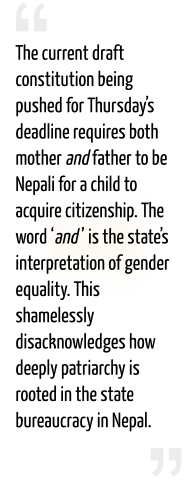
Women’s plight in the current round of constitution-making says a lot about Nepal’s nationalism impasse. A male-centric polity underneath its liberal sliver, Nepal is one of just twenty-seven countries on earth barring women from conferring citizenship to their children. The revolutionary spirit of the 2006 uprising had ensured that the interim constitution granted the conferring right to Nepali women for the first time in history. But as time passed and imaginary fear grew among the ultra-nationalists that foreigners (read Indians) may overrun Nepal by marrying Nepali women, the leaders quietly altered the draft constitution. The current draft constitution being pushed for Thursday’s deadline requires both mother and father to be Nepali for a child to acquire citizenship. The word ‘and’ is the state’s interpretation of gender equality. This shamelessly disacknowledges how deeply patriarchy is rooted in the state bureaucracy in Nepal.
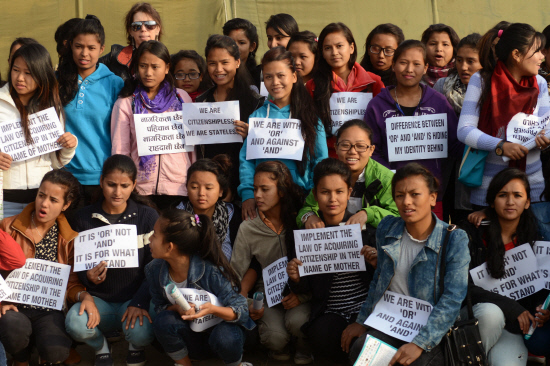 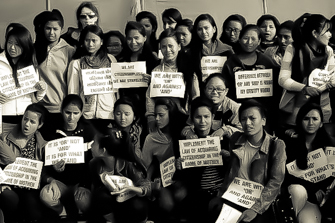 The tragic absurdity of the millions of Nepali women
facing the patriarchal system of citizenship acquisition
It is estimated that four million Nepalis are stateless today. Majority of them – raised by single mothers under varying circumstances ranging from divorce to rape – are unable to satisfy the sinister inquiries of the patriarchal officers. “Why couldn’t you think of the consequences before sleeping with a man who isn’t here today to sign the application form”, a single mother of a citizenship applicant was asked by the district official in a room full of people. Social media routinely asserts in a fact-of-the-matter way that Nepali women are betraying the nation by marrying foreigners. Ironically enough, the same state grants citizenship to foreign women marrying Nepali men, the very next day of the wedding, without requiring them to be residents in Nepal, let alone acquiring Nepalese languages and swearing loyalty to the state. Nepali men are seen in control of their women. Women not under men’s control are seen as whores.
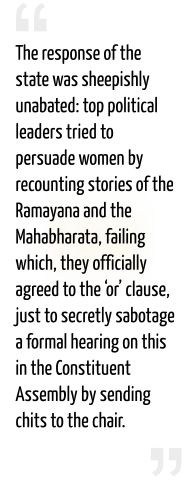
Protesting the newly proposed bill on citizenship requiring both mother and father to be Nepali, women waged a spontaneous ‘OR not AND’ campaign. This twist in the plot would have surely pleased poet Alok Dhanwa, that a nation separating wives from whores and lovers was finally confronted with women demanding personhood regardless of their sexual status. The response of the state was sheepishly unabated: top political leaders tried to persuade women by recounting stories of the Ramayana and the Mahabharata, failing which, they officially agreed to the ‘or’ clause, just to secretly sabotage a formal hearing on this in the Constituent Assembly by sending chits to the chair. The rotten revolution stank worse as the so-called liberals and the moderate Left – the Nepali Congress and the UML – stubbornly defended patriarchal nationalism, even after an oppositional alliance of thirty ragtag parties, ranging from the Maoists, Janajatis and Madheshis, had come on board to support women, just as they struggled for their own respective demands for various aspects of multiculturalism to be accepted into the constitution being written by an increasingly mono-cultural state. Once again, women’s call for an alteration in this not-yet-issued Constitution has been conveniently buried under the chaos of Party scuffle.
|

On January 22, 2015, the Nepali Constituent Assembly (CA) was expected to promulgate a new constitution, in the making since the landmark elections of 2008. Yet what happened, however, was another bandh from the Maoists and their allies and an open fight at the CA. A new keystone for the young republic turned into another resounding failure, harbinger not of a new era but of an old style political deadlock.
Since its Maoist revolution almost a decade ago, Nepal has morphed from a reclusive Hindu kingdom into a vibrant and diverse democracy, with newfound freedom fostering the vitality of a burgeoning civil society, all against the backdrop of a successful economic and social development. While these trends must undoubtedly be taken as positive, it is on the political level that a new Nepal is found missing.
Indeed, the political strife that has engulfed the country since the end of the civil war in 2006 has so far failed to deliver the long lasting-promises people fought for. If the decade-long war was above all a struggle for the rights of the oppressed and marginalised – low castes, ethnic and tribal minorities, the politicians in charge of implementing this agenda have so far squandered their opportunities, preferring to squabble over petty issues while thriving on corruption.
Former Nepalese Maoist Prime Minister Pushpa Kamal Dahal
was criticised for his opulent lifestyle
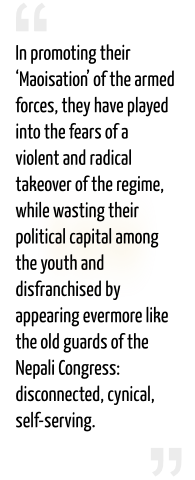
Among the culprits are the Maoists, who have grown from political heroes following their resounding victory in the 2008 elections to masters of division and back door political games. In promoting their ‘Maoisation’ of the armed forces, they have played into the fears of a violent and radical takeover of the regime, while wasting their political capital among the youth and disfranchised by appearing evermore like the old guards of the Nepali Congress: disconnected, cynical, self-serving.
The current deadlock is not their sole responsibility, but they have so far failed to address meaningfully the issues raised by their electoral base. While these are socio-economic – a fairer repartition of resources, from the dominating Bahun-Chhetris to the low-caste, the current bout of rebellion has more to do with the balance of power on a territorial level.
During their fight against the monarchy, the Maoists made a priority of enlarging their support base to the Janajatis (indigenous tribes) of the mountains and the Madhesis of the plains, promising them a decentralised Nepal with a devolution of power to newly created states.
However, during their stay in power, the Maoists have proven to be tepid regarding the political rights of those they vowed to defend, preferring to share the spoils of war rather than addressing the pressing issue of nation building and the constitutional and federalist issues. Their erstwhile allies decided to take the matter into their own hands, taking for granted that one is best served when answerable only to one’s own community.
What ensued was the creation and maturation of various regional and ethnic parties, from the Madhesi Jana Adhikar Forum, speaking in the name of the Madhesis from the Terai plain, to the Federal Socialist Party, voicing the concerns of the various Janajatis, such as the Gurung, Rai, Limbu or Tamang.
Ethnic distribution of Nepal:
the permanent temptation of federalism
It is in this fractious political climate that the issue of federalism is now hotly debated. It has become the new chocking point of the young republic, leaving behind the Maobadis and their revolutionary daydreams.
The primary aim of these ethnic and regional parties is to radically alter the old-age preferences and privilege of the Kathmandu elite, and by extension, that of the upper caste tandem of the Bahun-Chhetris (Brahmans-Kshatriyas). Nonetheless, with more than a hundred ethnic groups officially recognised, what constitutes a viable federation remains open to questioning. The stakes are high, between a balkanised, fissiparous state and a highly centralised and rigid one.
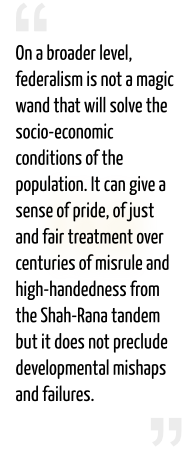
On a broader level, federalism is not a magic wand that will solve the socio-economic conditions of the population. It can give a sense of pride, of just and fair treatment over centuries of misrule and high-handedness from the Shah-Rana tandem but it does not preclude developmental mishaps and failures. The recent experiences of Jharkhand and Chhattisgarh in next-door India are cases in point. The first has been under President’s Rule for almost two of the past five years, while the second is rife with Naxalism.
Beyond the rationale for political and social development, two lessons can be drawn from this Nepali experience that began with the 2008 elections and that has passed a new milestone with the January 22 deadline – regardless of the latter’s actual outcome.
The first is that one needs to acknowledge the progress in the political transition: inclusive, it brought new voices in the political arena, deepened the democratic institutions, created a secular spirit and maintained peace throughout all those difficult years.
The second is that however real and precious this political vigour might be, it remains fragile, and the gains, reversible, with a country growing politically restless. On the issue of secularism, for instance, we observe a recent reinvigoration of the Hindutva strand in Nepal, with parties and associations demanding the return of a Hindu kingdom, no doubt emboldened by the victory of the BJP in India and the recent visits of Narendra Modi to Nepal.
Finally, the recent aspirations to ethnic-based states could fuel further resentment between communities, turning the country into a new Bosnia, where each minority would claim particular rights, thus trumping any sense of belonging to a common nation.
There is, then, a careful balance to be struck between an orthodox unitarism on the one hand, and radical separatism on the other, in order for the Nepalis to be able to express their diversity in a united country – a country where a multiethnic and multicultural society is taking root, with urbanisation and migration acting as catalysts for a new society to emerge. Interethnic and inter-caste marriages are becoming more frequent while the Nepali Pravasis – more than three million – are reshaping the old ‘identity politics’, toward a new sense of Nepaliness. Too often, the political establishment is failing to grasp these social changes, held back by a narrow vision of what shall be a common polity. The time has come for a Naya Nepal.
|
|
Mallika Shakya is an Economic Anthropologist working on labor movements, trader communities and development. She examined the rise and fall of readymade garment industry in Nepal, and then followed the trajectories of Marwari trader diaspora in South Asia and South Africa. Gradually, she became interested in concepts of nationalism especially in the postcolonial context. She has taught in the University of Pretoria and the University of Oxford, and currently she teaches at South Asian University, Delhi. Prior to joining academia, she worked over a decade for the United Nations and the World Bank where she advised governments in Asia and Africa on their policies for development.
|
|
Guillaume Gandelin is a France-based freelance writer. He studied International Relations and Geopolitics at SciencesPo Aix en Provence, writing a master thesis on Naxalism while participating in an exchange program at Delhi University. After various stays in Delhi as a quality engineer in transportation and junior fellow at the Observer Research Foundation, he is now back in France, involved in the making of geopolitical TV shows.
|
|
